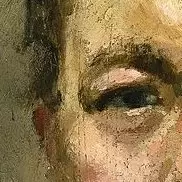Robert Delaunay chose the view into the ambulatory of the Parisian Gothic church Saint-Séverin as the subject of his first series of paintings, in which he charted the modulations of light streaming through the stained-glass windows and the resulting perceptual distortion of the architecture. The subdued palette and the patches of color that fracture the smooth surface of the floor point to the influence of Paul Cézanne (his work bridged the gap between impressionism & cubism) as well as to the stylistic elements of Georges Braque’s (his work in Fauvism led to cubism) early Cubist landscapes. Delaunay said that the Saint-Séverin theme in his work marked “a period of transition from Cézanne to Cubism.”
Delaunay explored the developments of Cubist fragmentation more explicitly in his series of paintings of the Eiffel Tower. In these canvases, characteristic of his self-designated “destructive” phase, the artist presented the tower and surrounding buildings from various perspectives. Delaunay chose a subject that allowed him to indulge his preference for a sense of vast space, atmosphere, and light, while evoking a sign of modernity and progress. Like the soaring vaults of Gothic cathedrals, the Eiffel Tower is a uniquely French symbol of invention and aspiration. Many of Delaunay’s images of this structure and the surrounding city are views from a window framed by curtains. In Eiffel Tower (painted in 1911, although it bears the date 1910) the buildings bracketing the tower curve like drapery.
The artist’s attraction to windows and window views, linked to the Symbolists’ use of glass panes as metaphors for the transition from internal to external states, culminated in his Simultaneous Windows series. (The series derives its name from the French scientist Michel-Eugène Chevreul’s theory of simultaneous contrasts of color, which explores how divergent hues are perceived at once.) Delaunay stated that these works began his “constructive” phase, in which he juxtaposed and overlaid translucent contrasting complementary colors to create a synthetic, harmonic composition. Guillaume Apollinaire wrote a poem about these paintings and coined the word Orphism to describe Delaunay’s endeavor, which he believed was as independent of descriptive reality as was music (the name derives from Orpheus, the mythological lyre player). Although Simultaneous Windows (2nd Motif, 1st Part) contains a vestigial green profile of the Eiffel Tower, it is one of the artist’s last salutes to representation before his leap to complete abstraction.
Jennifer Blessing


I think the author is discussing the movement of art into abstraction. From Baroque to Cubism art became increasingly abstract. It went from representing “real” people and things to emotions. And in cubism and surrealism, an ideal the artists strove for was to paint emotions as purley as possible to the point of attempting to express directly from the subconscious. And yes, the artists wanted their works to be suggestive but not exact so an amount could be open to interpretation. And with that I personally think they got a little too carried away (I’m not super into cubism or abstract art - but that’s just me personally).
Got it thanks!
You think that the artists got top carried away, as in with abstraction in general, or wanting thier work to be more open to interpretation?
With abstraction. To me it all looks like very safe art - hampton inn art.